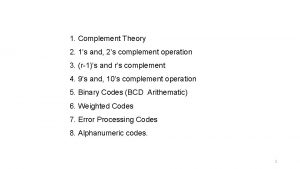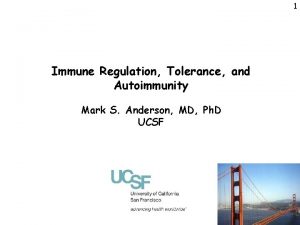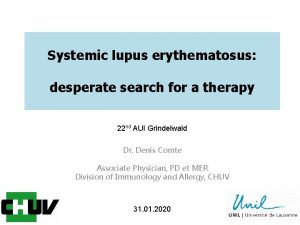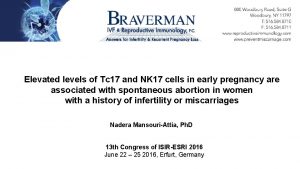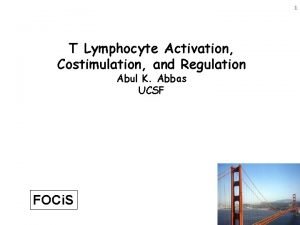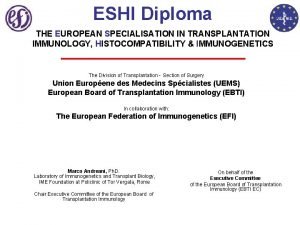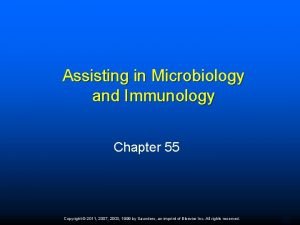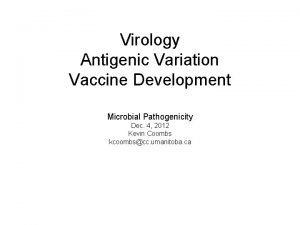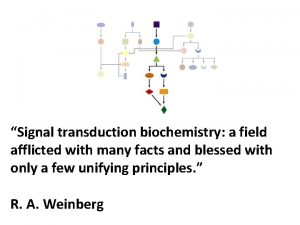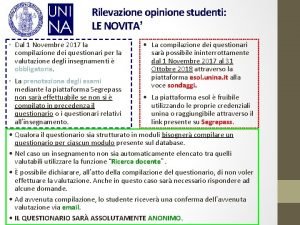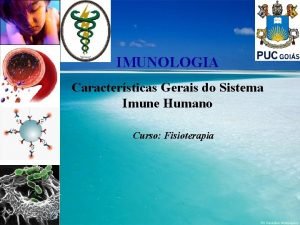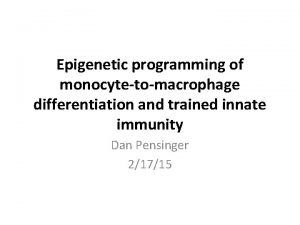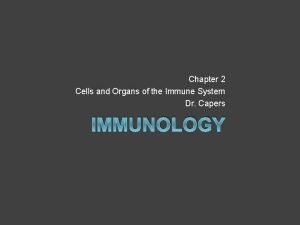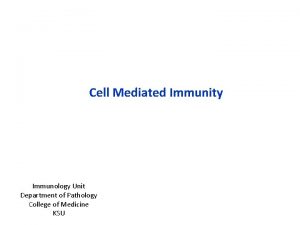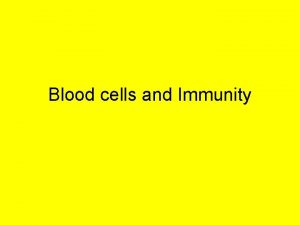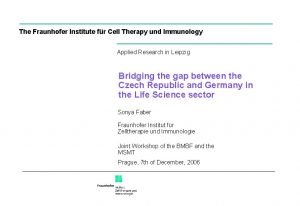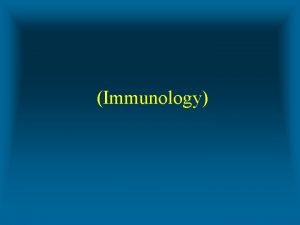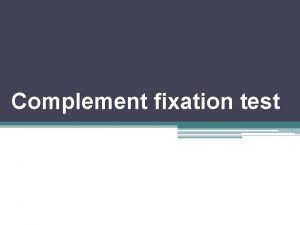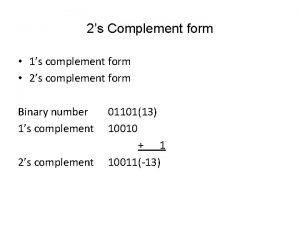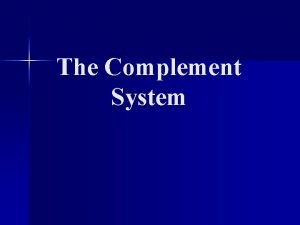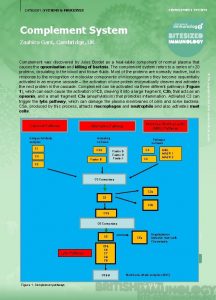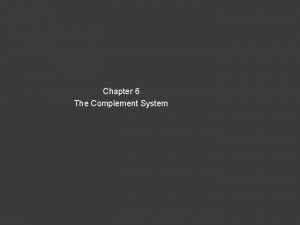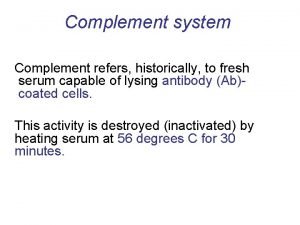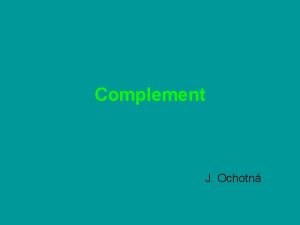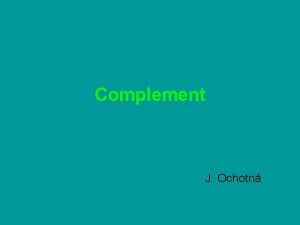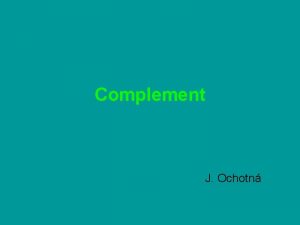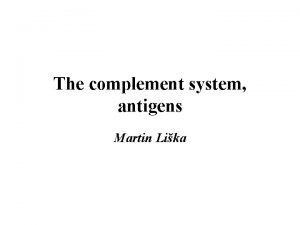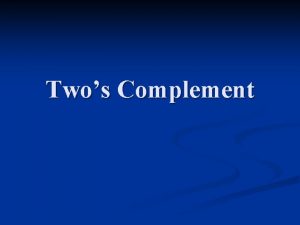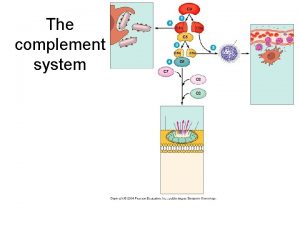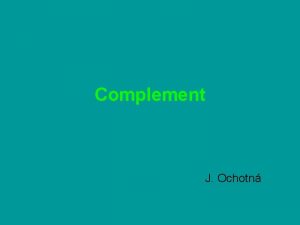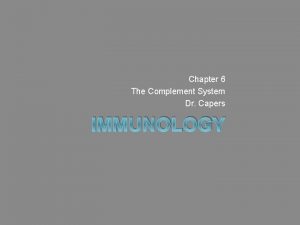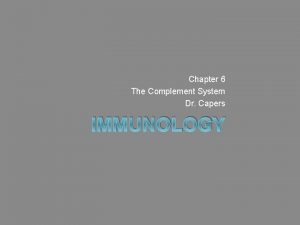Complement system The Complement C system in immunology






















- Slides: 22

Complement system

�The Complement (C) system in immunology refers to a system consisting of some (approximately 20) non-specific proteins present in normal human and animal serum �Term “complement” refers to the ability of these proteins to complement i. e. augment the effects of other components of the immune system �Complement is an important component of our innate host defenses

�Term complement was coined by Paul Ehrlich because it augmented the action of antibody �Constitutes 10 -15 % of total human serum globulins �They are heat-labile, inactivated at 560 C for 30 minutes �Synthesized mainly by the liver �Also produced by blood monocytes, tissue macrophages, epithelial cells of GIT and genitourinary tracts

�C ordinarily does not combine with free antigen or antibody, but only with antigen-antibody complex �Among Igs, only Ig. M, Ig. G 3, Ig. G 1 and Ig. G 2 in that order fix complement �This property is due to the presence of C binding site on the Fc portion of these immunoglobulins

�Complement system consists of about 20 proteins which include the complement components, the properdin system and the control proteins �The action of complements act as a cascade (one event must occur before another takes place)

• C 1(q, r, s), C 2, C 3, C 4, C 5, C 6, C 7, C 8, C 9 • factors B, D, H and I, properdin (P) • mannose binding lectin (MBL), MBL associated serine proteases (MASP-1 MASP-2) • C 1 inhibitor (C 1 -INH, serpin), C 4 -binding protein (C 4 -BP), decay accelerating factor (DAF), Complement receptor 1 (CR 1), protein-S (vitronectin)

�Activation of Complement : �Initiated either by antigen-antibody complexes or by a variety of non-immunologic molecule like bacterial endotoxin, lipopolysaccharides, zymosan (yeast cell wall) �Sequential activation of complement components occurs via one of the 3 pathways � 1) Classical pathway � 2) Alternate pathway � 3) Lectin pathway


�In the classical pathway, antigen-antibody complexes activate the pathway �In the alternative pathway, many cell surface substances initiate the process - bacterial lipopolysaccharidess (endotoxin), fungal cell wall, viral envelopes etc �In the lectin pathway, mannan-binding lectin (MBL) binds to the surface of microbes bearing mannan ( a polymer of mannose) and this activates the process


�Action of membrane attack complex (MAC): �Insertion of MAC to the target cells leads to disruption of the membrane and entry of water and loss of electrolytes from the cell, thus resulting in cytolysis

�Regulation of complement system: �Destruction of tissues by excessive activity of complement is prevented by regulation �Control of the complement cascade in normal serum is exerted by: �Inhibitors – halt the complement cascade �Inactivators – destroy the complement proteins

�Regulation of the complement system: � 1) the complement binding site on the H chain of Ig. M and Ig. G is available to the C 1 component only if antigen is bound to the antibody � 2) C 1 inhibitor inactivates the protease activity of C 1, thus to activate the classical pathway the process should proceed past this point by generating sufficient C 1 to overwhelm the inhibitor

� 3. Regulation of the alternative pathway is mediated by the binding of factor H to C 3 b and cleavage of this complex by factor I, a protease. �The pathway can proceed beyond this regulatory point only if sufficient C 3 b attaches to cell membranes which protects it from degradation by factor H and I

� 4. Properdin protects the C 3 b and enhances activation of alternate pathway � 5. Decay accelerating factor ( DAF, CD 55) – a glycoprotein located on the surface of human cells provides protection of cells from lysis � It acts by binding to C 3 b and C 4 b and limits the formation of C 3 convertase and C 5 convertase, this prevents the formation of membrane attack complex

�Biological effects of complement : � 1) Bacteriolysis and cytolysis: � insertion of membrane attack complex to cells lysis of bacteria, erythrocytes, tumor cells etc � 2) Amplification of inflammatory response: �C 3 a, C 4 a, C 5 a are anaphylatoxic by degranulation of mast cells to release histamine and other mediators �They cause increased vascular permeability, smooth muscle contraction �C 567 is chemotactic

� 3) Hypersensitivity reactions: �Complement participates in type II (cytotoxic) and type III (immune complex) hypersensitivity reactions � 4) Opsonization: �Facilitates the destruction of pathogens by phagocytic cells by binding of C 3 b to the receptors on phagocytes

� 5) Immune adherence: �C 3 and C 4 bound antigen-antibody complexes adhere to RBCs, platelets and are thus rapidly recognised by phagocytes � 6) Endotoxic shock: �Endotoxin activated complement cascade leads to excessive C 3 activation and platelet adherence �Platelet lysis releases large amount of platelet factors leading to disseminated intravascular coagulation (DIC)

� 7)Autoimmune diseases: �Serum complement levels are decreased in diseases like systemic lupus erythematosus and rheumatoid arthritis thus may be involved in pathogenesis of them

�Clinical aspects: �Deficiencies of complement: �Leads to poor host resistance against infections and results in recurrent bacterial and fungal infections and collagen disorders

Deficiency Disease C 1 inhibitor Hereditary angioneurotic oedema C 1, C 2, C 4 components Systemic lupus erythematosus, other collagen vascular diseases C 3 and its regulatory protein C 3 b inactivator Recurrent pyogenic infections C 5, C 6, C 7, C 8, C 9 components Bacteremia, mainly by Gram negative diplococci, toxoplasmosis

�Quantitation of complement: �Complement activity in serum is measured by estimating the highest dilution of the serum that lyses sheep RBCs sensitized by anti-erythrocytic antibody �Complement components can be measured by radial immunodiffusion method ( does not differentiate active and inactive fractions)
 Venn diagram symbols n
Venn diagram symbols n 1s and 2s complement
1s and 2s complement Phagocyte
Phagocyte Paraprotein
Paraprotein Central tolerance and peripheral tolerance
Central tolerance and peripheral tolerance Elsever
Elsever Braverman reproductive immunology
Braverman reproductive immunology Cells
Cells Abbas basic immunology
Abbas basic immunology Eshi diploma
Eshi diploma Pcams immunology
Pcams immunology Assisting in microbiology and immunology
Assisting in microbiology and immunology Nature reviews immunology
Nature reviews immunology Nature reviews immunology
Nature reviews immunology Esol unina
Esol unina Molecular immunology ppt
Molecular immunology ppt Trends in education
Trends in education Nature reviews immunology
Nature reviews immunology Pals immunology
Pals immunology Kuby immunology
Kuby immunology Tumor immunology
Tumor immunology Nature reviews immunology
Nature reviews immunology Fraunhofer institute for cell therapy and immunology
Fraunhofer institute for cell therapy and immunology

